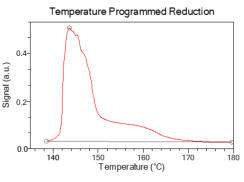




Expertise in the Physical
Characterisation of Materials

MCA Services
Unit 1A Long Barn, North End, Meldreth, Cambridgeshire SG8 6NT UK
01763 262333
© MCA Services




Temperature Programmed Analytical Options
Temperature Programmed Desorption (TPD)
Temperature Programmed Reduction (TPR)
Temperature Programmed Oxidation (TPO)
Our
temperature
programmed
analytical
options
are
chemisorption
analyses
used
to
investigate
desorption,
oxidation
and
reduction
as
a
function
of
temperature.
Traditionally
these
analytical
techniques
have
been
applied
to
catalysis
fields,
where
the
study
of
surface
reactions
with
temperature
are
fundamental
to
the
development
of
high
efficiency
systems
and
to
their
re-generation.
Temperature
programmed
analyses
are
also
beneficial
to
other
systems
where
surface
reactions
occur
during
their
use,
for
example in the study of re-activation conditions of adsorbents and filter systems.
Temperature Programmed Desorption (TPD)
At
MCA
we
use
our
Micromeritics
3Flex
Chemi
TCD
instrument
for
temperature
programmed
desorption.
This
is
usually
undertaken
under
ambient
conditions
of
pressure,
replicating
those
typically
found
during
normal
applications
of
materials.
Samples
are
pre-treated
to
clean
their
surfaces
before
the
desired
gas
is
chemically
adsorbed
to
the
active
sites
to
the
point
of
saturation.
The
temperature
of
the
chemisorption
stage
can
be
selected
so
that
the
usual
industrial
application
is
replicated
if
appropriate.
Temperature
is
then
increased
at
a
steady
rate
with
inert
gas
flow
over
the
sample
and
the
desorption
of
the
chemically
adsorbed
species
measured
using
a
Thermal
Conductivity
Detector
(TCD).
The
temperature
at
which
desorption
occurs
and
the
quantity
of
gas
desorbed
provides
valuable
information
for
determining
the
number
and
heterogeneity
of
active
sites, the strength of chemisorption and conditions for re-generation of samples.
Temperature Programmed Reduction (TPR)
TPR
is
used
to
investigate
the
reducibility
of
a
sample,
for
example
metal
oxide
supported
catalysts,
zeolites
and
hydro-cracking
catalysts,
although
the
reduction
of
many
different
compounds
can
be
investigated.
The
analytical
process
typically
involves
heating
a
sample
in
a
stream
of
reducing
gas,
usually
hydrogen
balanced
with
an
inert
gas.
Hydrogen
usage
caused
by
the
reduction
of
the
sample
is
measured
by
a
TCD,
the
temperature
range
of
reduction
is,
therefore,
established.
Furthermore,
since
the
TCD
is
precisely
calibrated,
the
volume of hydrogen consumed can be calculated.
Temperature Programmed Oxidation (TPO)
TPO
is
particularly
suited
to
the
study
of
metallic
catalysts,
for
example
those
used
for
the
oxidation
of
organic
compounds.
TPO
provides
a
measure
of
the
extent
to
which
a
catalyst
can
be
re-oxidised.
The
most
common
analytical
method
involves
fully
reducing
a
the
metal
or
metal
oxide
catalyst
sample
and
then
heating
it
at
a
constant
rate
either
in
a
steady
flow
of
an
oxidising
gas
mixture
or
with
pulses
of
the
oxidising
gas
mixture.
The
passage
of
the
oxidising
gas
mixture
(O2
balanced
with
an
inert
carrier)
through
the
sample
cell
is
measured
by
a
TCD,
allowing
the
temperature
at
which
the
sample
is
oxidised
to
be
found.
Precise
calibration
of
the
TCD
also
allows
for
the
oxygen
uptake
by
the
sample
to
be
quantified.







Expertise in the Physical
Characterisation of Materials
MCA Services
Unit 1A Long Barn, North End,
Meldreth, Cambridgeshire SG8 6NT UK
01763 262333
© MCA Services






01763262333
Temperature Programmed Desorption (TPD)
Temperature Programmed Reduction (TPR)
Temperature Programmed Oxidation (TPO)
Our
temperature
programmed
analytical
options
are
chemisorption
analyses
used
to
investigate
desorption,
oxidation
and
reduction
as
a
function
of
temperature.
Traditionally
these
analytical
techniques
have
been
applied
to
catalysis
fields,
where
the
study
of
surface
reactions
with
temperature
are
fundamental
to
the
development
of
high
efficiency
systems
and
to
their
re-generation.
Temperature
programmed
analyses
are
also
beneficial
to
other
systems
where
surface
reactions
occur
during
th
eir
use,
for
example
in
the
study
of
re-activation
conditions
of
adsorbents and filter systems.
Temperature Programmed Desorption (TPD)
At
MCA
we
use
our
Micromeritics
3Flex
Chemi
TCD
instrument
for
temperature
programmed
desorption.
This
is
usually
undertaken
under
ambient
conditions
of
pressure,
replicating
those
typically
found
during
normal
applications
of
materials.
Samples
are
pre-treated
to
clean
their
surfaces
before
the
desired
gas
is
chemically
adsorbed
to
the
active
sites
to
the
point
of
saturation.
The
temperature
of
the
chemisorption
stage
can
be
selected
so
that
the
usual
industrial
application
is
replicated
if
appropriate.
Temperature
is
then
increased
at
a
steady
rate
with
inert
gas
flow
over
the
sample
and
the
desorption
of
the
chemically
adsorbed
species
measured
using
a
Thermal
Conductivity
Detector
(TCD).
The
temperature
at
which
desorption
occurs
and
the
quantity
of
gas
desorbed
provides
valuable
information
for
determining
the
number
and
heterogeneity
of
active
sites,
the
strength
of
chemisorption
and
conditions for re-generation of samples.
Temperature Programmed Reduction (TPR)
TPR
is
used
to
investigate
the
reducibility
of
a
sample,
for
example
metal
oxide
supported
catalysts,
zeolites
and
hydro-cracking
catalysts,
although
the
reduction
of
many
different
compounds
can
be
investigated.
The
analytical
process
typically
involves
heating
a
sample
in
a
stream
of
reducing
gas,
usually
hydrogen
balanced
with
an
inert
gas.
Hydrogen
usage
caused
by
the
reduction
of
the
sample
is
measured
by
a
TCD,
the
temperature
range
of
reduction
is,
therefore,
established.
Furthermore,
since
the
TCD
is
precisely
calibrated,
the
volume
of
hydrogen consu
med can be calculated.
Temperature Programmed Oxidation (TPO)
TPO
is
particularly
suited
to
the
study
of
metallic
catalysts,
for
example
those
used
for
the
oxidation
of
organic
compounds.
TPO
provides
a
measure
of
the
extent
to
which
a
catalyst
can
be
re-oxidised.
The
most
common
analytical
method
involves
fully
reducing
a
the
metal
or
metal
oxide
catalyst
sample
and
then
heating
it
at
a
constant
rate
either
in
a
steady
flow
of
an
oxidising
gas
mixture
or
with
pulses
of
the
oxidising
gas
mixture.
The
passage
of
the
oxidising
gas
mixture
(O2
balanced
with
an
inert
carrier)
through
the
sample
cell
is
measured
by
a
TCD,
allowing
the
temperature
at
which
the
sample
is
oxidised
to
be
found.
Precise
calibration
of
the
TCD
also
allows
for
the
oxygen
uptake
by
the
sample
to
be quantified.























